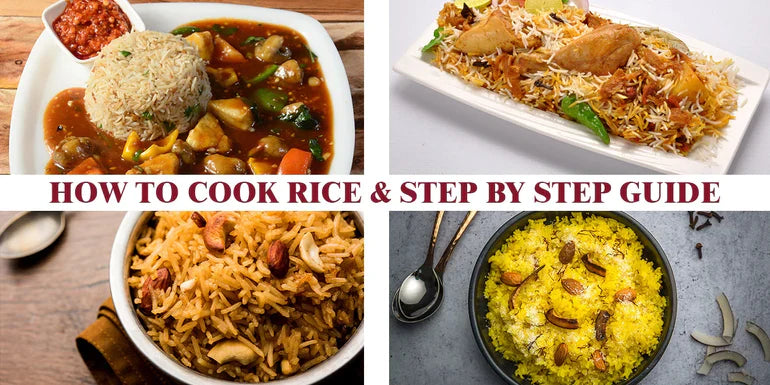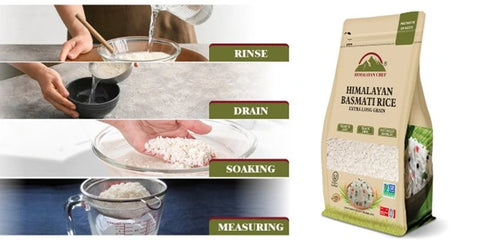How to Cook Basmati Rice: A Step-by-Step Guide for Fluffy and Delicious Results
Posted by HIMALAYAN CHEF

Master the art of cooking basmati rice to perfection! Embrace our comprehensive step-by-step guide for achieving impeccably fluffy and delightfully aromatic rice every single time. Unveil the hidden techniques for attaining the ideal consistency and taste through our expert advices.
Choosing Best Basmati Rice
Keep the following in mind while buying basmati rice:
Basmati Rice Origin: Authentic basmati rice is primarily cultivated in the regions of India and Pakistan. Look for brands that source their rice from these areas, as they have a long-standing tradition of producing high-quality basmati rice.
Basmati Rice Types: There are different varieties of basmati rice available, each with its own unique characteristics. Some popular types include Super Kernel Basmati and Kianat Basmati. Experiment with a range of options to discover the distinct flavors and textures that best suit your palate and preferences.
Grain Length: Basmati rice is known for its long and slender grains. Longer grains generally indicate higher quality. Look for rice with grains that are at least 6 to 8 millimeters in length.
Aroma: The fragrance of basmati rice is characterized by its unique qualities, often described as a delightful blend of nutty and floral aromas. This aroma is an essential characteristic of high-quality basmati rice. You can gently smell the rice to assess its fragrance before purchasing.
Packaging: Thoroughly inspect the packaging for any evidence of impairment or tampering. Opt for basmati rice that comes in sealed, airtight packaging to ensure freshness and prevent moisture from entering.
Age of Rice: Aged basmati rice is considered superior in quality as it develops a more pronounced aroma and flavor. Look for rice that has been aged for at least 12 months or more. Some brands specify the aging period on the packaging.
Authenticity Certifications: Look for certifications or labels on the packaging that indicate the rice's authenticity. For example, the "Basmati Rice" certification mark from the Basmati Export Development Foundation (BEDF) in India ensures that the rice is genuine basmati.

Best Quality Himalayan Chef Basmati Rice
Our Basmati Rice has all these qualities. These rice grains have a length of 7 mm and originate from the fertile territories of Pakistan. The long and slender grains of Himalayan Chef Basmati Rice are a testament to its high quality, with grains having delightful nutty and floral aroma. Our rice comes in resealable craft bags and airtight plastic jar packaging, preserving its freshness and preventing moisture from compromising its quality. The exquisite flavor and fragrance of Himalayan Chef Basmati Rice are enhanced by subjecting it to a meticulous aging process of at least 24 months or even longer.

Measuring and Washing Basmati Rice
Measuring and washing basmati rice properly is crucial for achieving the desired texture and flavor. Here's a step-by-step guide on how to measure and wash basmati rice:
Measure the Rice
- Determine the amount of rice you need based on your recipe or serving size. A prevalent guideline suggests using a ratio of 1 cup of uncooked rice to yield approximately 3 cups of cooked rice, establishing a balanced proportion between the raw and cooked state.
- Use a measuring cup to measure the desired amount of basmati rice. Ensure the measuring cup is dry and level off the rice without packing it tightly.
Rinse the Rice
- Place the measured rice in a fine-mesh strainer or colander.
- thoroughly wash the rice by allowing tape water to run over it, gently swirling the rice with your fingers during the rinsing process.
- Continue the rinsing process until the water runs clear, ensuring the removal of any residual starch and impurities from the rice grains.
Soak the Rice
- Soaking the rice is optional but recommended as it improves texture and reduces cooking time.
- Once rinsed, transfer the rice to a bowl and add an ample amount of cold water, ensuring that the rice is fully submerged.
- Let the rice soak for about 15-30 minutes. This step aids in the absorption of water by the grains, leading to the attainment of rice with a fluffy texture.
Drain the Rice
- After soaking, drain the rice thoroughly. Use the same fine-mesh strainer or colander to remove excess water.
- Shake or tap the strainer to remove excess water. Ensure the rice is well-drained before cooking.

Cooking Basmati Rice on the Stove
- Rinse the Himalayan Chef Basmati Rice thoroughly.
- Use the appropriate water-to-rice ratio. Add 2 parts water to 1 part rice for regular long-grain white rice. Adjust the ratio for different rice varieties as per package instructions.
- Bring the water to a boil and add a pinch of salt.
- Lower the heat, cover tightly, and simmer gently.
- Avoid stirring or uncovering the pot during cooking to prevent gummy rice. Cook for about 18 minutes or as directed on the package.
- Let the cooked rice sit, covered, for 10 minutes to steam.
- Fluff the rice with a fork before serving.

Expert Tips for Fluffy Basmati Rice
Following are the tips to make rice fluffy:
- Choose a pot with a heavy bottom to prevent burning or scorching and ensure better heat control during cooking.
- Lightly toast the basmati rice with olive oil before adding water. This enhances flavor and helps the grains slide against each other without becoming starchy.
- Adding a small amount of oil, even if you skip the toasting step, is beneficial for the texture of the rice.
- Sautéing rice reduces cooking time.
- Use the correct water-to-rice ratio, as mentioned in the previous section, to avoid undercooked or soggy rice.
- Cover the pot while simmering the rice and maintain a low simmer throughout the cooking process.
- Avoid stirring the rice while it cooks to ensure uninterrupted cooking.
- Once the rice is cooked, take the pot off the heat and maintain it covered for a duration of 10 minutes.
- This evens out moisture distribution in the rice, preventing dryness on top and sogginess at the bottom.
- Fluff the rice with a fork before serving.

Soaking Basmati Rice for Better Texture
Moisture Absorption: Soaking allows the rice grains to absorb water, which leads to more even cooking. The absorbed moisture helps the rice grains cook evenly from the outside to the center, resulting in a uniform texture.
Softening the Grains: Soaking softens the outer layer of the rice grains, which helps them cook faster and more evenly. This results in rice with a tender and fluffy texture.
Reducing Cooking Time: When rice is soaked, it starts to hydrate, which reduces the overall cooking time. Soaking can help cook the rice more quickly and efficiently, saving time in the cooking process.
Enhanced Elongation: Soaked basmati rice tends to elongate and become longer when cooked. This elongation adds to the visual appeal of the rice and gives it a distinct and desirable appearance.
Fluffier Results: Soaking allows the starch on the surface of the rice grains to break down and be washed away during rinsing. This leads to less surface starch, resulting in individual, fluffy grains of rice when cooked.
Adding Aromatics and Spices for Flavor
Adding aromatics and spices can elevate the flavor of basmati rice and make it more delicious. Here are some common ways to incorporate aromatics and spices when cooking basmati rice:
Sautéing Aromatics: Before adding water to cook the rice, you can sauté aromatics such as finely chopped onions, garlic, ginger, or shallots in a little oil or ghee. This step enhances rice flavors and adds depth to the dish.
Whole Spices: Adding whole spices to the rice while it cooks imparts a fragrant aroma and subtle flavors. Cardamom pods, cinnamon sticks, cloves, bay leaves, and star anise are common whole spices used in basmati rice. You can either add them directly to the cooking water or tie them in a cheesecloth or spice bag for easy removal later.
Ground Spices: For a stronger flavor, ground spices can be incorporated into the rice. Common ground spices used in basmati rice include turmeric, cumin, coriander, paprika, or garam masala. Mix the spices with a little oil or ghee before adding them to the rice to enhance their flavors.
Fresh Herbs: Adding fresh herbs such as cilantro, mint, or parsley to the cooked rice can brighten the flavors and add a fresh, aromatic element. Finely chop the herbs and sprinkle them over the rice just before serving.
Saffron: Saffron is a highly prized spice that adds a beautiful golden color and delicate floral aroma to basmati rice. Soak a few strands of saffron in a tablespoon of warm milk or water for a few minutes, then drizzle it over the cooked rice before serving.

Basmati Rice Variations and Serving Ideas
Vegetable Pulao
Sauté onions, garlic, and a mix of colorful vegetables like peas, carrots, bell peppers, and green beans. Add the sautéed vegetables to cooked Himalayan Chef Basmati Rice along with aromatic spices like cumin, coriander, and turmeric. Mix well and serve as a flavorful one-pot meal.
Biryani
Aromatic spices such as cinnamon, cardamom, and cloves are blended with basmati rice and a choice of meat (such as chicken, lamb, or shrimp) to create the popular and fragrant dish known as Biryani. Layer the partially cooked rice with the meat and spices, and cook until the rice is fully cooked. Enhance the dish with fried onions, fresh herbs, and nuts for a flavorful presentation.
Rice Salad
Cool cooked basmati rice and toss it with a variety of fresh vegetables, herbs, and a tangy dressing to make a refreshing rice salad. You can add ingredients like diced tomatoes, cucumbers, bell peppers, fresh herbs like mint and parsley, and dress it with a lemon vinaigrette or yogurt-based dressing.
Lemon Basmati Rice: Add fresh lemon juice and zest to cooked basmati rice for a refreshing and citrusy flavor. It pairs excellently with grilled or roasted chicken, fish, or vegetables.
Coconut Basmati Rice
Cook basmati rice in coconut milk instead of water for a creamy and slightly sweet taste. It complements Thai or Indian curries, tropical fruit salsas, or spicy stir-fries.
Conclusion
In conclusion, cooking basmati rice to perfection involves key steps such as selecting quality rice, measuring water accurately, and adjusting soaking times based on personal preference. Basmati rice can be enjoyed in a wide array of dishes, from biryanis to fried rice and rice salads. By mastering these techniques and exploring different flavors, basmati rice can be transformed into a delightful and satisfying addition to any meal.
TAGS:
SHARE:


